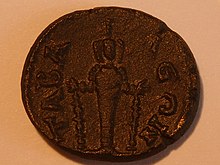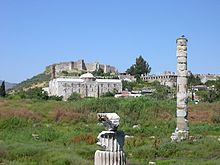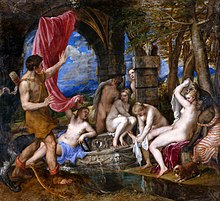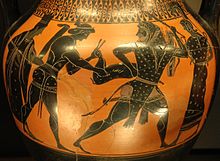Artemis
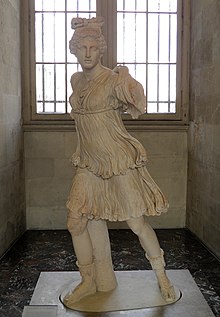

Artemis ( ancient Greek Ἄρτεμις ) is in Greek mythology the goddess of the hunt , the forest , childbirth and the moon as well as the guardian of women and children. She is one of the twelve great Olympian gods and is therefore one of the most important deities in Greek mythology. She is the daughter of Zeus and Leto and the twin sister of Apollo . Diana corresponds to her in Roman mythology .
etymology
The origin of the name is still unclear today. The earliest attested forms of the name Artemis refer in Mycenaean Greek to a-te-mi-to ( ???? ) and a-ti-mi-te ( ???? ), which was found in Linear B in Pylos . Her nickname qe-ra-si-ja ( ???? ) had become too ancient Greek Therasía (Θερασία), which perhaps means "goddess of Thera ". It is believed that a predecessor of Artemis was worshiped in Minoan Crete as the goddess of the mountains and the hunt, Britomartis (Βριτόμαρτις "sweet maiden").
Ancient Greek writers linked Artemis ( Doric Artamis ) in the context of ancient folk etymology to artemḗs (ἀρτεμής) “safe and sound” or ártamos (ἄρταμος) “butcher”. Another attempt at derivation connects the name variants Arktemis and Arktemisa with the Greek word árktos "bear" (to Proto-Indo- European * h 2 ŕ̥tḱos ), which allows a reference to the myth of Callisto , which was actually directly related to Artemis (Arcadian epithet kallisto ). In this case, Artemis would have been associated with a bear cult , which is ritually documented for the goddess in the Attic Brauron . It would be a remnant of a more widespread bear cult that was also found in the vicinity of other Indo-European deities, e.g. B. the Gallic Artio .
In addition to these explanatory approaches, the connection with Anatolian names is mainly emphasized, especially since Artemis was venerated in Lydia under the name Artimus .
Attributions
Attributes

Her best-known attributes are the silver arrows and the silver bow, which was given to her by the Cyclops and which also symbolizes the crescent moon. With this she sent accurate arrows against mortals to bring disease upon them. The spear and the hunting net are seldom their attributes. Among the plants, wormwood (Latin Artemisia absinthium ) and the cypress , the moor lily and the palm are sacred to her.
The animals of the forest are also generally regarded as their attributes, in particular the deer and the Kerynite hind , but also bear and boar. In addition, she is portrayed as a calf or yam carrier or accompanied by bulls. In connection with her aspects as a river and spring deity, she is associated with fish, especially the puffer fish.
As the sister of Apollo and as the goddess who loves the dance and the round dance, she plays the lyre , in her assimilation to Hecate she is like this torchbearer. As early as Homer, she was driving a chariot pulled by deer made entirely of gold.
Nickname
As diverse as the aspects of Artemis were their cult names and epithets . Widespread throughout the Greek cultural area, it was addressed with national as well as local epithets. Homer calls her potnia theron , "mistress of animals", and Agrotera , huntress. As Agrotera she owned an important sanctuary in Attica , but she was venerated under this name in Sparta , where sacrifices were made to her before the battle.
Her place of birth gave the goddess the nickname Kynthia ( Latin: Cynthia , "(the) coming from Mount Kynthos"). Another epithet of the goddess is Phoibe (Latin Phoebe ), after her grandmother and in alignment with the naming of her brother Phoibos Apollon . She also had the nickname Delia , "the native of the island of Delos". According to the Greek legend, Artemis and her brother Apollon were born on Mount Kynthos on the island of Delos . Her nicknames Kourotrophos , who identified her as the “guardian of youth”, and Locheia , with whom she was called by childbearing women and midwives, were also supraregional . Artemis Triklaria , for which human sacrifice has been recorded, was widespread in Ionia .
Regional Epithets of Artemis were, for example Alpheiaia , Alphaionia or Alpheiousa , as in Elis Letrinoi and Ortygia at Syracuse , where they had their own sanctuaries. According to legend, she had successfully evaded the river god Alpheios , who flowed under the sea to Ortygia in search of her. In Sparta she was also worshiped as Aigineia , the “hunter of the chamois ”, and as Orthia , the “high, great goddess”, or as Lygodesma , the “willow-bound”, because her statue was found standing upright on a willow. especially in Messinia was Limnatis revered. In Athens she could be identified with Aphaia . In Naupaktos , after the city was occupied by the Aitolians , the Aitole had a cult and the Venetians also had a sanctuary dedicated to the Aitole . In Patrai , Laphrai , to whom live animals and fruits were sacrificed on the fire altar, had their cult, as did Triklaria . Another epiclesis for the goddess Artemis was Selasphoros (ancient Greek Σελασφόρος , "light bearer"). Artemis Pergaia owned a cultural center in Pamphylia in Perge , where a big festival was held every year. The reverse of coins from cities in nearby Pisidia shows that there were so-called branch cults along with other sanctuaries of Artemis Pergaia in these cities.
A special form of Artemis is the Artemis Ephesia , which was worshiped in the famous large temple dedicated to her in Ephesus , one of the Seven Wonders of the World. It is considered to be the synthesis of Artemis of Greek immigrants with a nature goddess of Anatolia. According to archaeological and literary evidence, her statue in Ephesus showed her upper body covered with breasts, which, according to Christian polemics, she should embody as the alleged breadwinner of all living things. According to another interpretation, it is bull testicles of the sacrificed bulls. No literary evidence can be cited for this interpretation that could prove a relationship between the Ephesian Artemis and some kind of bull cult. A more recent interpretation suggests seeing a kurša hunting bag in the breasts , which were worshiped by the Hittites . A connection with the clinical picture of a polymastia glandularis with missing nipples as in the multi-breasted Artemis is also discussed.
Aspects
Artemis is mostly described as a virgin huntress who wanders through the woods alone or accompanied by virginal nymphs . The aspect of virginity, which she preserves and defends with the greatest tenacity, she shares with Hestia or Athena , and her followers were expected to preserve virginity.
Artemis has the reputation of a cruel and severe goddess. Her relationship with the male sex is strained as she blames men for the labor pains of women. In her role as guardian of the birthing mothers, she is sometimes equated with Eileithyia or Hera . The destructive aspect of Artemis was especially honored with the waning moon. Artemis was a wild, untamable goddess who not only gives but also takes life and for whom human sacrifices could be practiced, such as Artemis Triklaria in Patrai .
In the Iliad , Artemis is called the "mistress of the animals" ( Potnia Theron ) , whose young are under her protection. Her companions, along with other Virgos, are dogs . Dogs are traditionally guardians of the gateway to the underworld; Artemis is sometimes seen as the underworld goddess, as she is equated with the magic goddess Hecate, among other things . She hunts for some legends on new moon nights , while on the other nights she drives the moon chariot across the sky. It protected women of all ages and children of both sexes. At the same time Artemis is counted among the fertility gods. Artemis was the first of the two twins to be born and was already helping her mother with Apollo's delivery. Therefore the women prayed to Artemis for an easy birth.
Artemis was identified with Hecate as early as the 5th century . In Hellenistic theology she was equated with the moon goddess Selene , in the Roman Empire then with various goddesses, especially as the moon goddess with Isis . The fact that Apollon and Artemis are twins is made clear in late antiquity by a dualism in their roles: Accordingly, they represented the stars sun and moon, Apollo equated with the sun god Helios , Artemis with Selene .
With the Romans it corresponded to Diana and with the Etruscans the Artumes .
myth
"Λητὼ δ 'καὶ Ἄρτεμιν ἰοχέαιραν Ἀπόλλωνα
ἱμερόεντα γόνον περὶ πάντων Οὐρανιώνων
γείνατ' ἄρ 'αἰγιόχοιο Διὸς φιλότητι μιγεῖσα."
"Leto gave birth to Apollo and Artemis, glad of the projectiles,
both of lovely form, like none of the heavenly gods,
Since she joins in love with the ruler who wears aegis ."
According to Hesiod , her parents are Leto and the supreme Greek god Zeus , and her twin brother is Apollo . Leto, impregnated by Zeus, was on the run from his jealous wife Hera . However, this meant that not a single place on earth should offer Leto a place to give birth. Eventually, Leto was picked up by the floating island of Delos . The goddess was in labor for nine days.

When the giants attacked the Olympic gods ( gigantomachy ), Artemis shot the giant Gration down with an arrow, who was then killed by Heracles with an arrow.

When Artemis' favorite companion Callisto was raped by Zeus and gave birth to Arkas , Artemis turned her into a bear and chased her away, as defloration was forbidden for the followers of the goddess. In another version, it was the jealous Hera who so punished Callisto. Zeus transferred Callisto to heaven as the " Great Bear " (Latin: "Ursa Major", Big Dipper ).
The best-known story about a meeting with a man is that of Aktaion , a grandson of Kadmos , who was a passionate hunter. When he was hunting again and looking for a cool place in the forest in the midday heat, he came to a shady valley which was dedicated to Artemis. In its bottom there was a grotto where the goddess was bathing. When Aktaion saw her naked, she turned him into a deer to prevent him from telling of this forbidden encounter. A little later, Aktaion was mauled by his own hunting dogs. One interpretation claims that Actaion was a holy king who married Artemis in her deer form and had to die at the end of his time.
In reality, this hunt was re-enacted by Artemis priestesses who were covered in dog-head masks and were hunting a man disguised as a deer.

A passionate hunter, Artemis befriended Orion , the magnificent and savage hunter. Her twin brother Apollon was angry about this and challenged Artemis to a competition: She would certainly not be able to hit a blurry point very far out in the sea with her arrow. Artemis managed this very well - and realized too late that she had pierced the head of Orion swimming there with it. That's why they made him a constellation in the sky, the shoulder star Betelgeuse bright lights, but whose head is heavier star visible.
Another myth sees Orion as the hunter who wanted to kill all wild animals in the world. The earth or Artemis itself then produced a scorpion , against which Orion could do nothing and which finally killed him, after which both were transferred to heaven as a constellation .
The seer Manto , a daughter of Teiresias , called on the Theban women to make sacrifices to the deity Leto. Niobe, however, tried to persuade the people not to make any more sacrifices to the goddess Leto . She justified this with the fact that she had fourteen children, seven boys and seven girls, and thus far surpassed Leto's two children. This angered the goddess, who had watched the events from Mount Kynthos, so that she asked her children Artemis and Apollon to give her satisfaction. Artemis killed the girls with a bow and arrow, Apollon the boys (a motif in numerous ancient sculptures ).
Meleagros , son of the Calydonian king Oineus and his wife Althaia , once forgot to make a sacrifice to Artemis while thinking of all the other gods. Thereupon this dispatched the terrible Kalydonian boar , which devastated the seed fields and all other cultivated fields. Meleagros, accompanied by Atalante , among others , went on the hunt for the animal.

Shortly before the start of the Trojan War , Artemis sent a calm because Agamemnon , the leader of the Achaeans , had killed a doe that was consecrated to her while hunting. Sometimes the reason given is that he boasted that he was a better shot than her. Artemis then claimed his eldest daughter, Iphigenia, to sacrifice. However, at the last moment Artemis had mercy on the girl, saved her from the sacrificial table, placed a doe on the altar and raptured Iphigenia as a priestess to Tauris (see above; see also: Iphigenia on Tauris ).
The third of Herakles' twelve tasks was to catch a sacred doe with golden antlers. When Artemis had to take her hunting test, this doe had been one of the five Zeus had chosen. After Heracles hunted the cow for a year and finally caught it, he incurred Artemis' anger that the doe had been consecrated to her. For details, see Kerynite doe .
References in modern literature
Anna Seghers published the sagas of Artemis in 1938 .
The Irish writer Eoin Colfer named his fictional character Artemis Fowl after the Greek goddess. In the third volume of the book series “Artemis Fowl - the secret code”, Fowl explains: “Artemis is usually a woman's name, after the Greek goddess of the hunt. But every now and then a man appears who, because of his talent for hunting, obtains the right to bear the name. "
In the book series to Percy Jackson Artemis is the third volume Percy Jackson: The Curse of the Titans kidnapped by Atlas, but freed by Percy, Grover and Thalia.
literature
- Christian Augè, Pascale Linat de Bellefonds: Artemis in peripheria orientali . In: Lexicon Iconographicum Mythologiae Classicae (LIMC). Volume II, Zurich / Munich 1984, pp. 766-771.
- Elinor Bevan: The Goddess Artemis and the Dedication of Bears in Sanctuaries. In: The Annual of the British School at Athens . Volume 82, 1987, pp. 17-22.
- Walter Burkert : Structure and History in Greek Mythology and Ritual. Berkeley / Los Angeles / London 1979, pp. 123-142.
- Elif Tül Eǧilmez: Representations of Artemis as a hunter in Asia Minor. Dissertation, Mainz 1980.
- Marc Föcking : Artemis. In: Maria Moog-Grünewald (Ed.): Mythenrezeption. The ancient mythology in literature, music and art from the beginnings to the present (= Der Neue Pauly . Supplements. Volume 5). Metzler, Stuttgart / Weimar 2008, ISBN 978-3-476-02032-1 , pp. 151-163.
- Wolfgang Helck : reflections on the great goddess and the deities associated with her. Munich / Vienna 1971.
- Buffie Johnson: Lady of the Beasts. Ancient images of the goddess and her sacred animals. Harper & Row, San Francisco 1988.
- Lilly Kahil : Artemis . In: Lexicon Iconographicum Mythologiae Classicae (LIMC). Volume II, Zurich / Munich 1984, pp. 618-753.
- Ulrike Muss: The Cosmos of Artemis from Ephesus . Vienna (2001). ISBN 978-3-900305-36-9 .
- Theodor Schreiber : Artemis . In: Wilhelm Heinrich Roscher (Hrsg.): Detailed lexicon of Greek and Roman mythology . Volume 1,1, Leipzig 1886, Col. 558-608 ( digitized version ).
- Erika Simon , Gerhard Bauchhenß: Artemis / Diana . In: Lexicon Iconographicum Mythologiae Classicae (LIMC). Volume II, Zurich / Munich 1984, pp. 792-855.
- Christiane Sourvinou-Inwood : Studies in Girl's Transitions. Kardamitsa, Athens 1988.
- Ulrich von Wilamowitz-Moellendorff : The belief of the Hellenes . Volume 2, Weidmann, Berlin 1931-1932, pp. 147-150 Online (1931, archive.org) .
Web links
- Artemis in the Theoi Project (English)
Individual evidence
- ^ John Chadwick , Lydia Baumbach : The Mycenaean Greek Vocabulary. In: Glotta , Volume 41, 1963, p. 176 fsv Ἂρτεμις, a-te-mi-to- (genitive); Christiane Souvinou: A-TE-MI-TO and A-TI-MI-TE. In: Kadmos , Volume 9, 1970, pp. 42-47; Tassos Christidis: Further remarks on A-TE-MI-TO and A-TI-MI-TE. In: Kadmos , Volume 11, 1972, pp. 125-128; a-ti-mi-te . Palaeolexicon, Word study tool of ancient languages.
- ↑ qe-ra-si-ja, Linear B. Palaeolexicon, Word study tool of ancient languages.
- ↑ ἀρτεμής. In: Henry George Liddell , Robert Scott : A Greek-English Lexicon . Perseus Digital Library.
- ↑ ἄρταμος , Henry George Liddell, Robert Scott: A Greek-English Lexicon , On Perseus Digital Library; Ἄρτεμις. In: Henry George Liddell, Robert Scott, A Greek-English Lexicon . Perseus Digital Library; Behind the Name: Meaning, Origin and History of the Name Artemis. Retrieved May 13, 2013 .
- ↑ Michaël Ripinsky-Naxon: The Nature of Shamanism: Substance and Function of a Religious Metaphor. State University of New York Press, Albany NY 1993, p. 32.
- ↑ Enrico Campanile in: Annali della Scuola Normale Superiore di Pisa , Vol. 28, 1959, p. 305; Giuseppe Restelli: La posizione dell'eolico dell 'Asia Minore (lesbico) e del tessalico rispetto all'antico eolico. In: Aevum, Vol. 37, 1963, pp. 307 and 312. Edwin L. Brown: In Search of Anatolian Apollo. In: Charis: Essays in Honor of Sara A. Immerwahr . Hesperia Supplement 33, 2004, p. 251.
- ↑ Oswald Szemerenyi: Etyma Graeca VII (35). In: Roland Bielmeier, Reinhard Stempel (ed.): Indogermanica et Caucasica: Festschrift for Karl Horst Schmidt on his 65th birthday. (= Studies in Indo-European language and culture). de Gruyter, Berlin / New York 1994, pp. 213-214, Google books ; see. also Philo Hendrik Jan Houwink ten Cate: The Luwian Population Groups of Lycia and Cilicia Aspera during the Hellenistic Period . Brill, Leiden 1961, p. 166, cited in this context by Edwin L. Brown: In Search of Anatolian Apollo. In: Charis. Essays in Honor of Sara A. Immerwahr . Hesperia Supplement 33, 2004, p. 252.
- ↑ Homer, Iliad 21, 470 and 471.
- ↑ Xenophon , Kynegetikos 6, 13; Bakchylides 11, 37-42.
- ↑ Xenophon, Hellenika 4, 2, 20.
- ↑ Pausanias 7:19 , 1-6.
- ↑ Pausanias 6:22 , 5; Scholion zu Pindar , Nemean Odes 1, 3 Pythian Odes 2, (7) 11)
- ↑ Strabon 8, 343.
- ↑ Pausanias 3:14 , 2.
- ↑ Pausanias 3:16 , 9-11.
- ↑ Pausanias 10:38, 12.
- ^ Strabo 5, 1, 9.
- ↑ Pausanias 7:18, 8-13.
- ^ Margret Karola, Johannes Nollé : Gods, cities, festivals. Asian Minor coins from the Roman Empire. State Coin Collection, Munich 2014 p. 61
- ↑ Robert Fleischer : Artemis of Ephesus and related cult statues from Anatolia and Syria. (= Études préliminaires aux religions orientales dans l'Empire romain, vol. 35). Brill, Leiden 1973, ISBN 90-04-03677-6 ; Robert Fleischer: Artemis Ephesia . In: Lexicon Iconographicum Mythologiae Classicae (LIMC). Volume II, Zurich / Munich 1984, pp. 755-763. Guy MacLean Rogers: The Sacred Identity of Ephesus. Routledge, London / New York 1991.
- ↑ Erika Simon : The gods of the Greeks. Munich 1969, p. 163; Karl Hoenn: Artemis. Change of shape of a goddess. Zurich 1946, p. 55 f .; Walter Wiebe: Thoughts of a doctor on the breast ornament of Artemis of Ephesus. In: Würzburger medical history reports 23, 2004, pp. 69–123; here: p. 70 f. and 88-90.
- ↑ Hieronymus , commentarium in Epistolam ad Ephesios libri tres praefatio (= ed. Migne L 26 col. 441): Paulus… scribebat ad Ephesios Dianam colentes…, sed illam multimammiam quam Graeci πολύμαστοeam vocant, ut scilicet ex ipsiuma quoque bestiarum et viventium esse nutricem. ("Paul wrote to the Ephesians, who venerated Artemis as those many-breasted whom the Greeks call πολύμαστον, as one can see from their picture itself, and they pretend that she is the nourisher of all animals and living beings"); Minucius 22, 5: Diana… est… Ephesia mammis multis et uberibus exstructa… (“The Artemis of Ephesus is made with many breasts and teats…”); Walter Wiebe: Thoughts of a doctor on the breast ornament of Artemis of Ephesus. In: Würzburger medical history reports 23, 2004, pp. 69–123; here: p. 73 f. and 76 f. Minucius translates anew: "Diana is sometimes a hunter in her boots, at Ephesus she is hung with many and lush [fertile] breasts", whereby u is interpreted as an adjective.
- ↑ Gérard Seiterle: Artemis - the great goddess of Ephesus. In: Ancient World . Volume 10, Issue 3, 1979, pp. 6-16; Walter Wiebe: Thoughts of a doctor on the breast ornament of Artemis of Ephesus. In: Würzburger medical historical reports , 23, 2004, pp. 69–123; here: p. 71 f. points out that according to Herodotus, the sacrificial animals were golden cattle, which, along with other arguments, makes Seiterle's interpretation of the bull's testicles unlikely.
- ↑ Beate Bergbach-Bitter: Greek cult images. Archaeological evidence and literary tradition. Würzburg, Dissertation 2008, pp. 316–321, uni-wuerzburg.de (PDF; 1.85 MB).
- ^ Sarah Morris: The prehistoric background of Artemis Ephesia: A solution to the enigma of her 'breasts'? In: Ulrike Muss (ed.): The cosmos of Artemis from Ephesus. Austrian Archaeological Institute, Vienna 2001, pp. 135–150.
- ↑ Walter Wiebe: Thoughts of a doctor on the breast ornament of Artemis of Ephesus. In: Würzburger medical historical reports , 23, 2004, pp. 69–123.
- ^ Already in Plato , Kratylos 406 b.
- ↑ Pausanias 7:19 , 1-6.
- ^ First proof of the identification in Aeschylus fr. 170. In: Tragicorum Graecorum Fragmenta , 1889 2
- ↑ Apuleius Metamorphoses 11, 2.
- ↑ Pausania's Description of Greece 10, 32, 13-17.
- ↑ Egon Gottwein: Hesiod: Theogonie. September 28, 2003, accessed May 13, 2013 (Greek, German).
- ↑ Eoin Colfer : Artemis Fowl - the secret code . List Taschenbuch, Berlin 2004, ISBN 3-548-60485-4 , p. 278.

